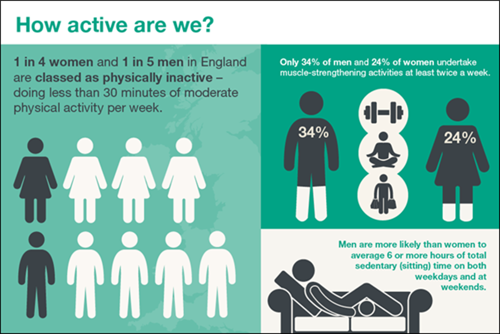Physical activity
A long-term trend away from manual occupations and toward more sedentary lifestyles and increased car ownership, means that people in the UK are around 20% less active now than in the 1960s. If current trends continue, we will be 35% less active by 2030[1]. Increasing physical activity has the potential to improve the physical and mental health and wellbeing of individuals, families, communities and the nation as a whole[2].

Source: Public Health England.
Physical inactivity is the fourth leading risk factor for global mortality accounting for 6% of deaths globally. People who have a physically active lifestyle have a 20% to 35% lower risk of cardiovascular disease, coronary heart disease and stroke compared to those who have a sedentary lifestyle. Regular physical activity is also associated with a reduced risk of diabetes, obesity, osteoporosis and colon and breast cancer and with improved mental health. In older adults physical activity is associated with increased functional capacities. The estimated direct cost of physical inactivity to the NHS across the UK is over £0.9 billion per year.
Department of Heath physical activity guidelines recommend that over a week adults should undertake a total of at least 150 minutes of at least moderate physical activity. Moderate activity can be achieved through brisk walking, cycling, gardening and housework, as well as various sports and exercise. Alternately, an adequate level of activity can be achieved over a week by undertaking 75 minutes of vigorous intensity activity such as running, football or swimming. All adults should also aim to improve muscle strength on at least two days a week and minimise sedentary activities.
In 2017/18, approximately two thirds of Herefordshire adults met the recommended level of physical activity of 150+ moderate intensity equivalent minutes per week, a figure similar to that reported for England. In the same period 23% of Herefordshire adults were physically inactive, again similar to England as whole.
15.1% of 15-year-olds in Herefordshire in 2014/15 were reported as partaking in at least one hour of physical activity daily; not significantly different to England as a whole. However, around two in every three (65.1%) had a mean daily sedentary time in the last week of over 7 hours per day, which was a lower proportion than reported for England (70.1%).
In addition to physical activity, the potential contribution of leisure more broadly to health is being viewed increasingly from a public and population health perspective where leisure is regarded as the domain of lifestyle where people have greatest control. Consequently, it is seen an important resource that can positively influence physical, psychological and spiritual health.[3]
In terms of active leisure activities, Herefordshire has indoor leisure or swimming facilities in Bromyard, Kington, Hereford, Ledbury, Leominster, Ross-on-Wye and Wigmore.
In addition, the River Wye, Malvern Hills, Black Mountains and Offa's Dyke long-distance path offer a variety of outdoor leisure opportunities. However, the percentage of adults who do any walking at least once a week or who do any cycling at least three times a week was in 2016/17 not significantly different from in England or the West Midlands region.
[1]Guidance: Health matters: getting every adult active every day, Public Health England.
[2]Guidance: Health matters: getting every adult active every day, Public Health England.
[3] Leisure, Health and Well-Being, R.C. Mannell, World Leisure Journal, Vol.49, No.3, 2007, pp.114-128.